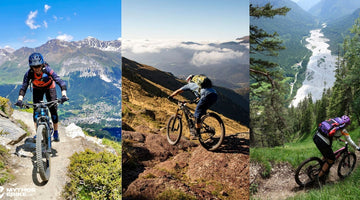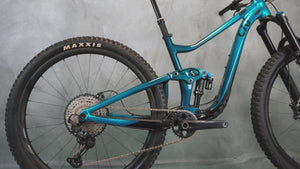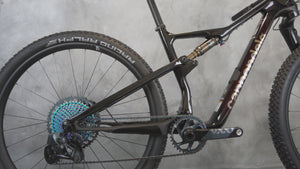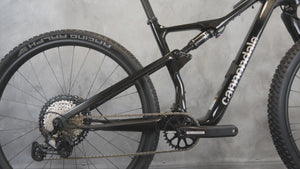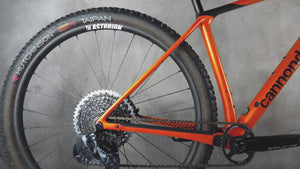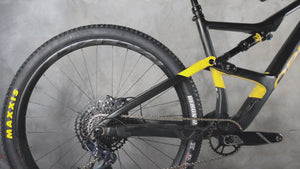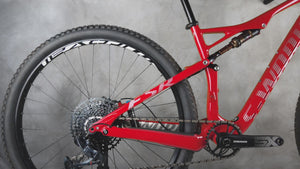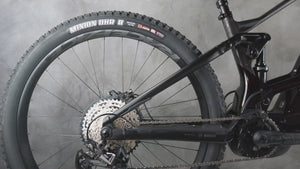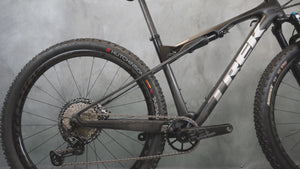Which MTB tires to choose?
In this Article
Published on Wednesday, October 2
How to choose the right mountain bike tyres? How do you know which tyre to put on a mountain bike rim? It's not always easy to answer these questions. 29-inch or 27.5-inch, 2.1 or 2.3 inches, 67 or 120 TPI? There are so many factors to consider when buying a new mountain bike tyre. With the wide range of options on the market, it can sometimes be difficult to navigate. In this article, we help you choose the right mountain bike tyre based on your riding style (XC, trail, enduro, downhill). We cover all the key elements you need to know to find the best mountain bike tyre that suits your needs.
The different characteristics of mountain bike tyres

Understanding the different characteristics of mountain bike tyres ©Hutchinson
When buying a mountain bike tyre, it's important to consider several criteria. Indeed, to make the right choice of mountain bike tyres, you must first determine what type of riding and conditions you want to use your tyres in. Several factors influence the bike's performance: tyre dimensions, of course, grip, and finally durability.
The dimensions of mountain bike tyres

The dimensions of mountain bike tyres are crucial. They greatly affect performance and riding comfort. Today, there are three main wheel sizes on the market: 29-inch (ETRTO 622), 27.5-inch (ETRTO 584), and 26-inch (ETRTO 559).
- 29-inch mountain bike tyre: This is the new standard for mountain biking. These tyres offer great roll-over capability and are perfect for technical terrain and long distances. Their size provides better stability and grip, especially on steep climbs and descents. However, they can be less manoeuvrable in tight corners. This size now equips most mountain bikes.
- 27.5-inch mountain bike tyre: These tyres offer a good compromise between 26- and 29-inch wheels. Although the majority of bikes now come equipped with 29-inch wheels, some trail or enduro bikes still use this standard for its versatility and manoeuvrability.
- 26-inch mountain bike tyre: This was once the standard tyre size for mountain bikes. They are now less common but can still be found on children's bikes.
The choice of dimension therefore depends on your riding style and the type of terrain you're tackling.
Which tyre width to choose: 2.0 / 2.1 / 2.25 / 2.3 / 2.4 / 2.6?

What tyre width to choose? 2.0 / 2.1 / 2.25 / 2.3 / 2.4 / 2.6 ©Hutchinson
Which width to choose for mountain bike tyres? The width of a mountain bike tyre, often referred to as the tyre section, directly influences comfort and performance. The width of a mountain bike tyre is expressed in inches. Today, most mountain bike tyres range between 2 and 2.4 inches.
A question of practice
Your riding style greatly influences the choice of tyre width:
- Fat Bike tyres: these are the widest tyres, ranging between 3.8 and 4.8 inches.
- Downhill and Enduro mountain bike tyres: they are between 2.4 and 2.6 inches wide.
- Trail and All-Mountain tyres: they are between 2.25 and 2.4 inches wide.
- Cross-country (XC) mountain bike tyres: they typically range between 2 and 2.4 inches.
What tyre size for what rim width?
Rim width plays a key role in determining the tyre size you’ll fit on your bike. Before purchasing a tyre, ensure that your rim width is compatible with the tyre width you want.
How to find the dimensions compatible with your rims?
On the sidewall of your tyres, you will find the ETRTO code of your tyre. ETRTO stands for “European Tyre and Rim Technical Organisation”. This organisation defines technical standards for tyres and rims in Europe.
The ETRTO code consists of two elements (XX-XXX). Example: 40-622
- The first 2 digits correspond to the internal width of the rim. This dimension is expressed in millimetres. This measurement allows you to determine compatibility with tyre widths.
- The last 3 digits represent the diameter of your rim: for example, a 29-inch mountain bike rim has a diameter of 622. This measurement is also expressed in millimetres.
Tyre/rim size compatibility chart

Tyre/rim size compatibility chart
The grip of a mountain bike tyre

The grip of a mountain bike tyre ©Orbea
The grip of a tyre is the result of a combination of its tread pattern, pressure, and rubber compound. Mountain bike tyres differ from gravel or road bike tyres due to their much more pronounced tread pattern, allowing cyclists to tackle the most challenging terrains. However, a mountain bike tyre is constructed in the same way as other tyres: a tread (more or less rolling depending on the profile), puncture protection (which varies according to the brand’s technology), and a softer or harder rubber compound.
Mountain bike tyre treads

Mountain bike tyre treads
We distinguish 3 main categories of mountain bike tyres. Each of these categories has its own tread style:
- Tyres for dry terrain
- Tyres for mixed terrain
- Tyres for wet terrain
Mountain bike tyres for dry terrain
Tyres for dry terrain are designed with low and generally close-set tread blocks. They provide low rolling resistance on hard-packed trails and are ideal for fast cross-country races (XC MTB) or rocky terrain. Their design offers optimal grip to maximise speed, but they may lack traction on slippery surfaces or in wetter conditions.
Mountain bike tyres for mixed terrain
Tyres for mixed terrain offer a balance between traction and versatility. With medium-sized, well-spaced knobs to ensure good grip on varied surfaces such as dirt, roots, or stones, they are perfect for those who ride their bikes in any conditions. These tyres are effective on slightly wet or dry terrains and provide good handling in most conditions.
Mountain bike tyres for wet terrain
Tyres for wet terrain feature deep, widely spaced knobs to better clear mud and increase grip on slippery surfaces. They are specifically designed to offer maximum traction in difficult conditions like muddy or wet trails, to prevent losing grip on climbs or corners. These less versatile tyres are best reserved for winter or rainy rides.
What tyre pressure for mountain biking?
Mountain bike tyre pressure generally ranges between 1 and 2.7 bars, depending on the terrain, tyre width, rider weight, and type of setup: tubeless or with inner tubes.

What tyre pressure for tubeless MTB?

Riding with inappropriate pressure can result in a loss of grip, an increased risk of puncture, and a reduction in comfort. It is therefore essential to adjust your tyre pressure correctly before each ride, taking into account the terrain you’ll be riding on.
The different types of rubber compounds

The different types of rubber compounds ©Maxxis
One of the factors that influences tyre performance is the type of rubber used in its construction. The hardness of a tyre's rubber is expressed in Shore (ShA). Each brand develops its own rubber formula. The key point to remember is that hard rubber increases tyre efficiency and makes it more durable. In contrast, a soft rubber compound will be less durable but provide better grip. It's always a matter of compromise! Entry-level tyres often feature a single rubber compound, whereas high-end tyres, for competition use, offer multiple compounds spread across the tread, knobs, and sidewalls.
The durability of a mountain bike tyre

The durability of a mountain bike tyre ©Hutchinson
Durability is one of the most important aspects of a tyre. Depending on your riding style and the terrain you ride on, a reinforced tyre will help reduce the risk of punctures. To assess tyre durability, look at the type of casing used and its reinforcements. Some competition tyres, to prioritise weight, are built without reinforcement, while downhill or enduro tyres feature significant reinforcement at the expense of weight. Again, it's all about compromise!
Mountain bike tyre casing
The casing of a mountain bike tyre is made up of different density threads. The number of threads in the casing is expressed in TPI (Threads Per Inch). This value ranges between 30 and 130 TPI, with the most common being 127 TPI or 66 TPI. Some brands even go as far as doubling these casings (2x66 TPI, for example) to meet the demands of extreme uses like Freeride MTB.
Key takeaways:
- The higher the TPI, the more the tyre will deform and offer good efficiency.
- The lower the TPI, the more resistant the tyre will be.
Mountain bike tyre reinforcements
There are many types of reinforcement to protect mountain bike tyres from punctures. Each brand develops its own technologies to meet customer needs. For instance, Hutchinson offers Hardskin reinforcement that covers the entire tyre casing, Maxxis has the Exo+ Protection, and Vittoria has the Trail Casing. Before buying a tyre model, make sure to choose the right reinforcement based on your riding style. Brands often offer the same model with different reinforcements.

Choosing the right mountain bike tyre mainly depends on your riding style and your rim width. Whatever model you decide to buy, the key is to choose one that suits your specific needs to optimise your comfort and performance. Brands like Hutchinson, Continental, Schwalbe, Maxxis, or Vittoria offer high-quality mountain bike tyres. If you're unsure which model to choose, check out our selection of the best mountain bike tyres.














